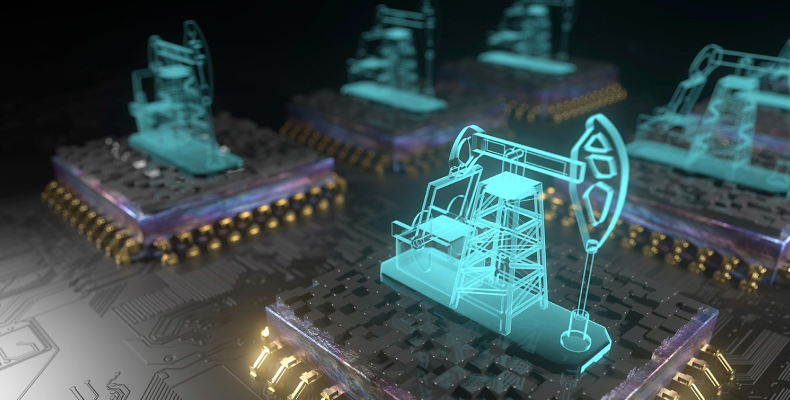Generative Artificial Intelligence in oil and gas can potentially revolutionize the oil and gas industry operating. Mainly because of its ability to optimize refinery processes, predict and manage risks, and monitor operations in real-time. This helps companies increase efficiency and save costs.
AI software development for oil and gas: A comprehensive guide

Vadym Zhernovyi
Author

March 11, 2024
Date

 13 minutes read
13 minutes read
Content
Darryl Williams, Corporate Vice President of Energy at Microsoft, rightly said, “Technologies like AI and machine learning can analyze the past, optimize the present, and predict the future.” It’s fair for most areas, from creative to the most scientific. The oil and gas sector is one of them.
In this article, we delve into Artificial Intelligence software development for oil and gas. We explain how AI capabilities can enhance the oil and gas sector, exploring existing solutions and areas for development.
What is Artificial Intelligence software development for oil and gas?
Thanks to AI, large oil and gas companies can access data from all their locations in one place. Thanks to this, they can remotely manage and monitor all their plants, facilitating informed decisions and optimizing operations. Moreover, digitizing data records is crucial to avoid incomplete records, which can be a significant issue in the industry. The impact of AI on the oil and gas industry is evident, revolutionizing its complex operations.
A trend and troubling concern
One concerning trend in applying AI in the oil and gas industry is the potential for cybersecurity vulnerabilities and data privacy issues. Here are key considerations:
- Cybersecurity vulnerabilities
- Data privacy and compliance
- Human-machine interaction
- Ethical considerations
- Data quality and bias
- Lack of skilled workforce
- Regulatory and compliance challenges
- Environmental impact
Benefits of AI in the oil and gas industry
AI has the potential to revolutionize the oil and gas industry, enhancing efficiency, safety, and decision-making while reducing costs and environmental impact. It enables data-driven decisions and maintains a competitive edge in a rapidly evolving industry. AI offers several benefits:
- Improved efficiency.Optimizing processes in exploration, drilling, and production while reducing downtime.
- Predictive maintenance.Predicting equipment failures for proactive maintenance is crucial in remote and harsh environments.
- Cost reduction.Identifying cost-saving opportunities in drilling and supply chain management.
- Enhanced safety.Real-time safety monitoring to prevent accidents in challenging environments.
- Data analysis.Processing vast amounts of data to gain insights into reservoir management and decision-making.
- Reservoir modeling.Creating detailed reservoir models for accurate predictions.
- Environmental monitoring.Detecting and mitigating environmental incidents.
- Exploration and geology.Efficiently processing seismic and geological data for resource identification.
- Supply chain optimization.Improving logistics and material availability.
- Market forecasting.Analyzing market trends for informed decisions.
- Customized solutions.Tailoring AI to specific operational challenges.
- Remote monitoring.Enabling remote equipment control in challenging locations.

Artificial Intelligence software development for oil and gas: Best practices
While some ways to apply AI potential to the oil and gas industry are more straightforward, some practices are not that obvious yet — highly recommended. The most prominent are:
- Defect detection and quality assurance. Implement computer-vision-based systems for quality control and defect detection.
- Ensure safety and security standards. Monitor safety compliance with AI-powered solutions to prevent accidents.
- Reduce production and maintenance costs. Use AI to predict corrosion and schedule maintenance, avoiding costly incidents.
- Make better decisions with analytics. Utilize big data-powered AI applications for data analysis and decision-making.
- Add assistance with voice chatbots. Deploy voice-enabled chatbots for field operators to enhance efficiency and safety.
- Uncover new insights in oil and gas exploration. Use AI-powered robots and drones for more precise exploration.
New revenue sources
In addition to all the abovementioned, AI allows oil and gas companies to generate entirely new sources of revenue. Data itself has become a valuable product. Companies can offer predictive-maintenance insights as subscription services to smaller operators. Others may license their AI models or sell aggregated operational data to energy traders, logistics firms, or environmental agencies. The space for ideas is enormous.
AI also helps to create new platforms and digital ecosystems. Through dashboards, monitoring tools, and analytics-based services, oil and gas firms can become data solution providers instead of solely resource producers.
With these options, companies become more resilient and future-ready. Rather than focusing solely on production volume, they can consider shifting or expanding their services.
AI as the catalyst for new business methods
AI’s real potential lies in helping oil and gas companies reconsider their business models. As businesses around the world shift toward cleaner energy, AI becomes a bridge between traditional operations and the latest technologies.
Instead of focusing solely on extraction or refining, companies can use AI to create brand-new services. For example, they can offer predictive-maintenance platforms to other operators or provide AI-powered energy-optimization tools to their clients. These services can create recurring revenue and reduce dependence on oil prices.
AI also helps integrate renewable energy sources, hydrogen systems, and carbon capture projects into existing infrastructure. With smart forecasting tools, companies can better juggle supply, demand, and sustainability.
Top AI for oil and gas
As for today, the leading oil and gas companies integrating AI into their operations are Shell, BP, and ExxonMobil.
Shell has deployed AI across its oil and gas supply chain, with over 160 active AI projects. It uses reinforcement learning in its exploration and drilling programme to reduce gas extraction costs. Automated drilling systems trained on collected data and data from simulations help the drill operator understand the environment, accelerating results and reducing maintenance and costs.
BP has partnered with Microsoft to implement its Azure cloud solutions, including machine learning for smarter drilling processes. It accelerated the data analysis and allowed faster and more effective decisions.
BP has invested in many AI companies to boost decision-making and optimize customers’ building energy profiles. They also use Machine Learning to detect leaks and alert users to facility risks by monitoring environmental changes, such as methane emissions.
ExxonMobil collaborated with IBM’s Data Science and AI Elite Team and seismic experts to use AI to interpret and integrate data from siloed systems into one repository. The repository is hosted in a multi-cloud environment, which enables faster decision-making across functions.
How is Artificial Intelligence transforming the oil and gas industry?
AI for oil and gas is reshaping the industry. It’s revolutionizing critical aspects of exploration, drilling, production, and supply chain management. It enables predictive maintenance, optimizing equipment efficiency and reducing downtime. At the same time, it enhances reservoir management through advanced data analysis. This leads to more accurate resource recovery predictions.
Real-time AI-driven adjustments improve efficiency and minimize risks. Environmental monitoring and energy management are strengthened, while safety and security are maintained by AI-powered surveillance systems.
Additionally, AI aids supply chain logistics, market analysis, and compliance. Ultimately, it leads to cost reduction, efficiency improvements, and environmental responsibility. Altogether, these practices help position the industry for greater sustainability and competitiveness.
How to integrate Artificial Intelligence in oil and gas software
Integrating AI for oil and gas is a complex process that requires collaboration, expertise, and a clear understanding of industry challenges. The process involves several steps and considerations. Here’s a guide on how to do it effectively:
Step 1: Determine where AI can have the most significant impact in addressing specific challenges.
Step 2: Gather and prepare high-quality data for AI model training.
Step 3: Choose the appropriate AI techniques for your use case.
Step 4: Develop AI models using selected techniques.
Step 5: Create interfaces to integrate AI models into existing systems.
Step 6: Implement real-time data processing solutions.
Step 7: Develop AI solutions for remote locations.
Step 8: Create user-friendly interfaces for operators and decision-makers.
Step 9: Prioritize cybersecurity and data privacy.
Step 10: Test and validate AI models and software integration.
Step 11: Invest in training for the workforce.
Step 12: Continuously monitor and update AI models as needed.
Step 13: Design AI systems that can scale with growing demands.
Step 14: Foster collaboration between domain experts, data scientists, and software engineers.
Step 15: Gather user feedback for ongoing improvements.

Top examples of AI in Oil & Gas
As for today, the leading oil and gas companies integrating AI into their operations are Shell, BP, and ExxonMobil. Let’s take a quick look at these examples of AI applications in Oil and Gas industry to understand what they do and how they do it.
Shell has deployed AI across its oil and gas supply chain, with over 160 active AI projects. It uses reinforcement learning in its exploration and drilling programme to reduce gas extraction costs. Automated drilling systems trained on collected data and simulation results help the drill operator understand the environment, accelerating results and reducing maintenance and costs.
BP has partnered with Microsoft to implement its Azure cloud solutions, including machine learning for smarter drilling processes. It accelerated the data analysis and allowed faster and more effective decisions. BP has invested in many AI companies to boost decision-making and optimize customers’ building energy profiles. They also use Machine Learning to detect leaks and alert users to facility risks by monitoring environmental changes, such as methane emissions.
ExxonMobil collaborated with IBM’s Data Science and AI Elite Team and seismic experts to use AI to interpret and integrate data from siloed systems into one repository. The repository is hosted in a multi-cloud environment, which enables faster decision-making across functions.
AI use cases for oil and gas
Artificial Intelligence has various use cases in the oil and gas industry. Here are some prominent AI applications:
Predictive maintenance. AI can predict equipment failures by analyzing historical data and sensor information. That enables proactive maintenance and minimizes downtime.
Reservoir management. AI enhances reservoir modelling by analyzing geological and seismic data. It results in more accurate predictions and improved decision-making in oil reservoir management.
Drilling optimization. AI algorithms adjust drilling parameters in real-time to improve drilling efficiency and reduce operational costs.
Production optimization. AI systems continuously monitor and control production operations, optimizing healthy parameters for maximum production.
Environmental monitoring. AI for oil and gas monitors ecological factors such as emissions and safety conditions. This helps to ensure compliance with regulations and reduce the environmental impact.
Supply chain management. AI saves you costs by optimizing supply chain logistics by predicting demand, managing inventory, and improving transportation.
Safety and security. AI-powered surveillance systems monitor remote sites for safety and security. This helps to prevent accidents and enhances overall safety.
Energy efficiency. AI optimizes energy consumption in facilities, reducing costs and environmental impact.
Natural language processing (NLP). NLP processes and analyses unstructured text data, such as reports and documents. Doing this can extract valuable insights, including market trends and sentiment analysis.
Remote sensing. AI analyzes data from remote sensors and drones for site assessment, monitoring, and surveillance in remote locations.
Market analysis and price forecasting: AI models analyze market trends, geopolitical factors, and pricing. This allows for more informed decision-making.
Digital twins: AI creates digital models of platforms and pipelines to simulate and optimize their maintenance.
Geospatial analysis: AI for oil and gas and Geographic Information Systems (GIS) analyze spatial data to identify optimal drilling and exploration locations.
Health and safety compliance: Artificial Intelligence in oil and gas can monitor and enforce health and safety compliance in real-time, reducing the risk of accidents.
Document automation: AI-driven document automation tools streamline administrative tasks, such as contract management and compliance reporting.
One step closer to a decarbonized future
Reducing emissions is now a top priority for the global energy sector, and AI is helping companies make progress in this journey. It analyzes real-time data from sensors, production systems, and energy grids to identify inefficiencies and reduce waste at every stage of the process.
In exploration and drilling, machine learning predicts leaks, minimizes flaring, and optimizes energy use during extraction. In refining, AI systems efficiently manage heat exchangers, cutting fuel consumption and carbon output. When applied to renewable projects, AI forecasts wind or solar production and helps balance it with conventional generation.
The same technology is improving carbon capture and storage (CCS) operations. AI can model how carbon dioxide moves underground, predict the safest injection points, and monitor performance in real time.
How AI for Oil and Gas is shifting business culture
For decades, oil and gas operations have relied on tried-and-true processes and hierarchical decision-making. AI challenges that approach, bringing data-first and collaborative ways of working. Teams that once worked in silos now collaborate closely with data scientists and software engineers. Engineers who previously relied on experience must now use AI and adapt to new workflows. It’s a shift from intuition to evidence, from fixed routines to constant learning.
Companies that foster this mindset of openness to experimentation, trust in data, and a constant willingness to learn and adapt to technical advances achieve tremendous success. AI adoption is not a technical and operational transformation, but a cultural one.
Data quality and other challenges
Data quality is the central pillar of AI in Oil & Gas. Yet, many companies still face fragmented systems, inconsistent formats, and missing information. Before any AI model can demonstrate results, the data feeding it must be complete, reliable, and connected.
To address this challenge, companies are investing in better data governance – digitizing records, standardizing formats, and linking data across exploration, production, and logistics. Once data is properly structured, Artificial Intelligence oil and gas systems can detect patterns and make predictions.
At the same time, open-source tools and shared datasets are playing an increasingly important role in the industry. By collaborating through open platforms, companies can experiment faster, reduce costs, and increase transparency. This approach also ensures that smaller firms can access advanced AI solutions without incurring prohibitive investment costs.
How to get the most from an AI application?
One of the most practical and high-impact uses of AI for Oil and Gas industry is predictive maintenance. Equipment failures can be costly, dangerous, and difficult to anticipate in remote environments. AI, in turn, predicts and prevents them. By analyzing patterns in vibration, temperature, and pressure data, AI systems can recognize subtle warning signs of wear or malfunction. Maintenance teams can then quickly fix issues, avoiding expensive repairs.
When combined with virtual models of real assets (so-called digital twins), predictive maintenance becomes even more powerful. The twin continuously learns from live data, helping teams simulate “what-if” scenarios and optimize performance under different conditions. For many operators, predictive maintenance has already become a cornerstone of AI transformation.
Conclusion
Integration of Artificial Intelligence in oil and gas industry holds great promise. It offers improved efficiency, safety, and informed decision-making. At the same time, it reduces costs and environmental impact. From predictive maintenance to enhanced reservoir management, AI brings practical solutions to various sector aspects. As companies embrace AI and best practices, they operate more intelligently, ensuring safety and environmental responsibility.
Artificial Intelligence software development for oil and gas with Blackthorn Vision
At Blackthorn Vision, we have expertise in Artificial Intelligence software development for oil and gas, able to drive transformative changes in the industry. Our AI developers excel in the latest technologies, enabling us to deliver tailored solutions that optimize operations and enhance supply chain management.
Contact us to discuss strategic partnership in embracing AI and unlocking new possibilities for your business.
FAQ
How can AI be the tool that transforms oil and gas for the future?
What companies are AI in oil and gas?
According to GlobalData’s thematic research report, Shell, BP, and ExxonMobil are the leading adopters of Artificial Intelligence in the oil and gas field.





































































